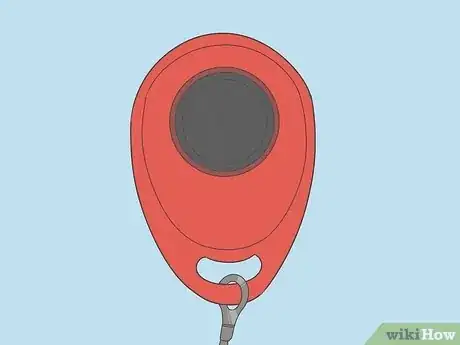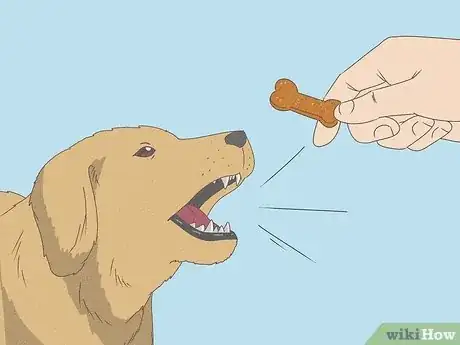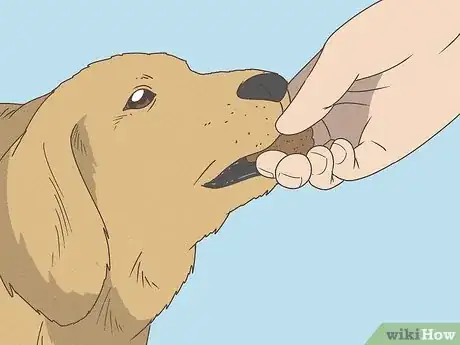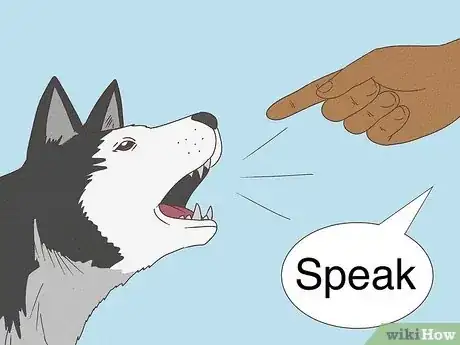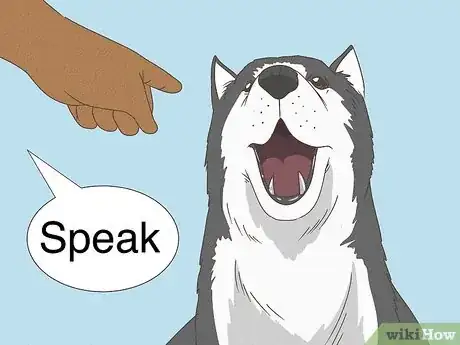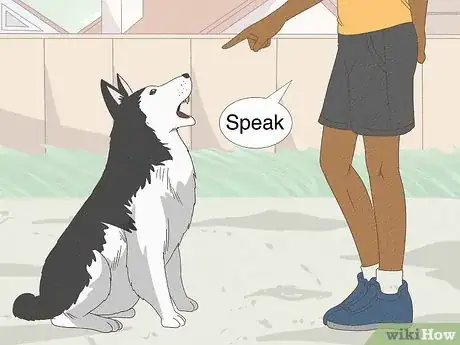This article was co-authored by Jessica Powell and by wikiHow staff writer, Eric McClure. Jessica is a Certified Professional Dog Trainer and the Owner of Proud Paws Dog Training, a small business offering private coaching and in-home dog training services to dog parents across the San Fernando Valley of Los Angeles, California. With nearly ten years of experience, she has extensive knowledge and experience in dog behavior, effective communication techniques, animal welfare, manners training, behavioral modification, and enrichment. Jessica holds a Bachelor of Science degree in Animal Management and is also an experienced shelter professional.
There are 9 references cited in this article, which can be found at the bottom of the page.
This article has been viewed 504,601 times.
Your dog won’t be reciting Shakespeare anytime soon, but teaching a dog to bark on command is actually one of the easiest tricks to teach. Barking is a natural behavior for a dog, so they should pick up on this one in no time. Teaching a dog to “speak” is a fun little trick, but it’s also useful if you want to show your dog when it’s appropriate to make noise, or get your dog to bark when they want something. In this article, we’ll break down everything you need to know about teaching your pup to talk on command.
Things You Should Know
- Begin training with high value treats or a clicker handy.
- Make use of situations in which you already know your dog will bark. Reward them with a treat or the clicker immediately after they make a noise.
- Introduce the 'Speak' command once your dog associates barking with a reward.
- Reinforce training over time to tie together the word and the behavior. Make use of short, repeated training sessions to prevent fatigue.
Steps
Expert Q&A
Did you know you can get premium answers for this article?
Unlock premium answers by supporting wikiHow
-
QuestionIs there a trick to getting my dog to bark? Until last week he barely barked, and we want him to be a guard dog as well as a companion.
 Pippa Elliott, MRCVSDr. Elliott, BVMS, MRCVS is a veterinarian with over 30 years of experience in veterinary surgery and companion animal practice. She graduated from the University of Glasgow in 1987 with a degree in veterinary medicine and surgery. She has worked at the same animal clinic in her hometown for over 20 years.
Pippa Elliott, MRCVSDr. Elliott, BVMS, MRCVS is a veterinarian with over 30 years of experience in veterinary surgery and companion animal practice. She graduated from the University of Glasgow in 1987 with a degree in veterinary medicine and surgery. She has worked at the same animal clinic in her hometown for over 20 years.
Veterinarian If the dog is a youngster, then be patient and give him time. Some dogs don't discover their bark until they're several months old, so there may be plenty of time yet for him to learn — and for you to wish he hadn't! Oftentimes, a trigger to a bark is something like a knock on the door or the doorbell. Try sitting next to a wall or door in the house, have a treat concealed in one hand, with the other concealed behind your back. Use the hidden hand to knock on the door. Most dogs will bark at this, in which case praise him and give the treat. If he doesn't bark, but merely cocks his head, praise this instead, the idea being to gradually build up to him barking.
If the dog is a youngster, then be patient and give him time. Some dogs don't discover their bark until they're several months old, so there may be plenty of time yet for him to learn — and for you to wish he hadn't! Oftentimes, a trigger to a bark is something like a knock on the door or the doorbell. Try sitting next to a wall or door in the house, have a treat concealed in one hand, with the other concealed behind your back. Use the hidden hand to knock on the door. Most dogs will bark at this, in which case praise him and give the treat. If he doesn't bark, but merely cocks his head, praise this instead, the idea being to gradually build up to him barking. -
QuestionWhat is a good age to train a dog to speak?
 Pippa Elliott, MRCVSDr. Elliott, BVMS, MRCVS is a veterinarian with over 30 years of experience in veterinary surgery and companion animal practice. She graduated from the University of Glasgow in 1987 with a degree in veterinary medicine and surgery. She has worked at the same animal clinic in her hometown for over 20 years.
Pippa Elliott, MRCVSDr. Elliott, BVMS, MRCVS is a veterinarian with over 30 years of experience in veterinary surgery and companion animal practice. She graduated from the University of Glasgow in 1987 with a degree in veterinary medicine and surgery. She has worked at the same animal clinic in her hometown for over 20 years.
Veterinarian This works best when you have a good level of understanding with the dog through basic training. You can start potty training from 8 weeks, and gradually get the dog used to learning "Sit" and other basics. After that it's a matter of the puppy being old enough to be able to bark, as some don't learn this until they're several months old.
This works best when you have a good level of understanding with the dog through basic training. You can start potty training from 8 weeks, and gradually get the dog used to learning "Sit" and other basics. After that it's a matter of the puppy being old enough to be able to bark, as some don't learn this until they're several months old.
Warnings
- If you’ve already got a dog who is prone to barking, teaching them “speak” before you’ve got the problematic barking under control is potentially a bad idea. Your dog may start barking expecting you to give them a reward.[13]⧼thumbs_response⧽
References
- ↑ https://www.humanesociety.org/resources/positive-reinforcement-training
- ↑ https://www.akc.org/expert-advice/training/clicker-training-your-dog-mark-and-reward/
- ↑ https://cpb-us-w2.wpmucdn.com/about.illinoisstate.edu/dist/6/45/files/2019/10/Chiandetti-Avella-Fongero-Cerri-2016-Can-Clicker-training-facilitate-cond-in-dogs.pdf
- ↑ https://www.petmd.com/dog/training/evr_dg_how-to-make-a-dog-bark
- ↑ https://www.akc.org/expert-advice/training/train-your-dog-to-speak/
- ↑ https://www.akc.org/expert-advice/training/train-your-dog-to-speak/
- ↑ https://www.akc.org/expert-advice/training/teach-your-puppy-these-5-basic-commands/
- ↑ https://www.akc.org/expert-advice/training/train-your-dog-to-speak/
- ↑ https://www.petmd.com/dog/training/evr_dg_how-to-make-a-dog-bark
- ↑ https://www.petmd.com/dog/training/evr_dg_how-to-make-a-dog-bark
- ↑ https://www.akc.org/expert-advice/training/reliable-recall-train-dogs-to-come-when-called/
- ↑ https://www.sfspca.org/sites/default/files/dog_commands_quiet.pdf
- ↑ https://www.thrivingcanine.com/should_i_teach_speak_to_eliminate_dog_barking_problems
About This Article
To teach your dog to speak, start by playing a game with it to make it excited and energetic. Then, once your dog is pumped up, hold out a treat in plain sight. Wait until your dog notices the treat, then quickly hide it behind your back. Your dog should start barking soon after you hide the treat. When it does, say "Speak," and give it the treat to reward the behavior. Keep practicing the trick every day, and start phasing out the treats until your dog barks on command when you say "Speak."

